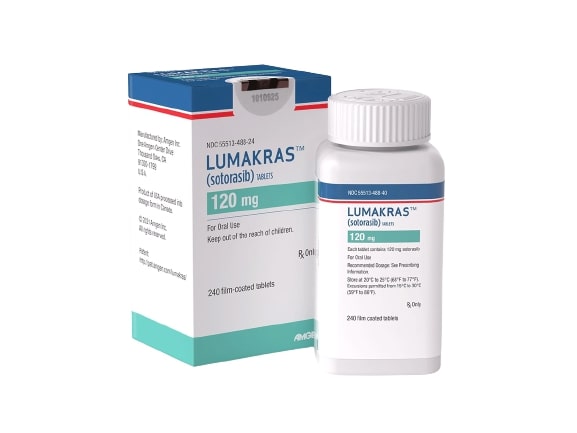Tecentriq (Atezolizumab) vs Lumakras (sotorasib)
Tecentriq (Atezolizumab) vs Lumakras (sotorasib)
Tecentriq (atezolizumab) is an immune checkpoint inhibitor that works by blocking the protein PD-L1, which is involved in suppressing the immune response against cancer cells, making it particularly effective for certain types of lung cancer, bladder cancer, and triple-negative breast cancer. Lumakras (sotorasib) is a targeted therapy that specifically inhibits the KRAS G12C mutation, a common mutation in non-small cell lung cancer (NSCLC), and is used when this specific genetic alteration is present. The choice between Tecentriq and Lumakras would depend on the patient's specific type of cancer and its genetic profile; therefore, molecular testing to identify genetic mutations like KRAS G12C is essential for determining the most appropriate treatment.
Difference between Tecentriq and Lumakras
| Metric | Tecentriq (Atezolizumab) | Lumakras (sotorasib) |
|---|---|---|
| Generic name | Atezolizumab | Sotorasib |
| Indications | Urothelial carcinoma, non-small cell lung cancer, small cell lung cancer, hepatocellular carcinoma, and melanoma | Non-small cell lung cancer with KRAS G12C mutation |
| Mechanism of action | PD-L1 inhibitor, immune checkpoint inhibitor | KRAS G12C inhibitor, targets the KRAS G12C mutation |
| Brand names | Tecentriq | Lumakras |
| Administrative route | Intravenous infusion | Oral |
| Side effects | Fatigue, decreased appetite, nausea, urinary tract infections, fever, and others | Diarrhea, musculoskeletal pain, nausea, fatigue, liver damage, and others |
| Contraindications | Patients with severe hypersensitivity to atezolizumab or any of its excipients | Patients with severe hypersensitivity to sotorasib or any of its excipients |
| Drug class | Monoclonal antibody, immune checkpoint inhibitor | Small molecule, kinase inhibitor |
| Manufacturer | Genentech (Roche) | Amgen |
Efficacy
Tecentriq (Atezolizumab) in Lung Cancer Treatment
Tecentriq (Atezolizumab) is an immune checkpoint inhibitor that has shown efficacy in the treatment of certain types of lung cancer. Specifically, it has been approved for use in patients with previously treated metastatic non-small cell lung cancer (NSCLC) and as a first-line treatment for certain patients with metastatic NSCLC whose tumors express PD-L1, without EGFR or ALK genomic tumor aberrations. Clinical trials have demonstrated that Tecentriq can extend overall survival in these patient populations compared to chemotherapy alone. The drug works by blocking the protein PD-L1, which is used by cancer cells to evade the immune system. By inhibiting this pathway, Tecentriq enables the immune system to better recognize and attack cancer cells.
Lumakras (Sotorasib) and Its Role in NSCLC
Lumakras (Sotorasib) represents a significant advancement in the treatment of lung cancer as the first approved targeted therapy for NSCLC with KRAS G12C mutation. This mutation was long considered "undruggable," but Lumakras has been specifically designed to target and inhibit the KRAS G12C mutant protein, which is involved in the growth and survival of tumor cells. In clinical trials, Lumakras has shown promising efficacy in shrinking tumors and slowing disease progression in patients with this specific genetic alteration, which is present in approximately 13% of patients with NSCLC.
Combination Therapy and Overall Efficacy
The potential for combining Tecentriq with other treatments, such as chemotherapy or targeted therapies like Lumakras, is an area of active research. The rationale behind combination therapy is to attack the cancer through multiple mechanisms simultaneously, potentially improving patient outcomes. While studies are ongoing to evaluate the efficacy and safety of such combinations, it is important to note that each medication has its own profile of effectiveness and is tailored to specific patient populations based on the molecular characteristics of their tumors.
Conclusion
Both Tecentriq and Lumakras have brought new hope to certain groups of lung cancer patients, offering more personalized and effective treatment options. Tecentriq has become a cornerstone in the immunotherapy landscape for lung cancer, while Lumakras has pioneered targeting a mutation that was once deemed intractable. The efficacy of these drugs marks a significant step forward in the management of lung cancer, with ongoing research likely to further refine and enhance their therapeutic potential.
Regulatory Agency Approvals
Tecentriq
-
European Medical Agency (EMA), European Union

-
Food and Drug Administration (FDA), USA

-
Health Canada

-
Pharmaceuticals and Medical Devices Agency (PMDA), Japan

-
Therapeutic Goods Administration (TGA), Australia

-
Medsafe (NZ)

Lumakras
-
European Medical Agency (EMA), European Union

-
Food and Drug Administration (FDA), USA

-
Medicines & Healthcare products Regulatory Agency (MHRA), United Kingdom

Access Tecentriq or Lumakras today
If Tecentriq or Lumakras are not approved or available in your country (e.g. due to supply issues), you can access them via Everyone.org.
How it works

Make an enquiry
Choose the medicine you want to buy, answer a couple of questions, and upload your prescription to speed things up. We’ll get back to you within 24 hours.


Make an enquiry
Choose the medicine you want to buy, answer a couple of questions, and upload your prescription to speed things up. We’ll get back to you within 24 hours.


Breeze through the paperwork
We'll guide you through the required documents for importing unapproved medicine, ensuring you have all the necessary information.


Get a personalized quote
We’ll prepare a quote for you, including medicine costs and any shipping, administrative, or import fees that may apply.


Receive your medicine
Accept the quote and we’ll handle the rest - sourcing and safely delivering your medicine.

Some text on this page has been automatically generated. Speak to your physician before you start a new treatment or medication.
Let's talk
If you have any questions, call us or send us a message through WhatsApp or email:
Contact us




